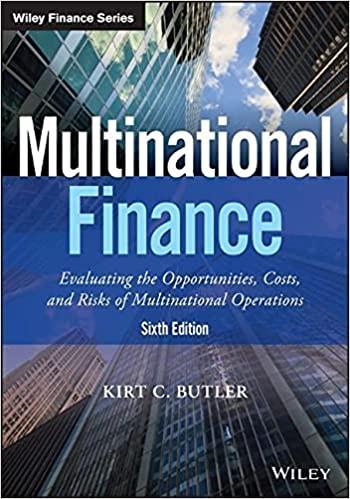Answered step by step
Verified Expert Solution
Question
1 Approved Answer
A manufacturer is planning to produce and sell a new product , it would cost $20 million at Year to capital at the beginning of

A manufacturer is planning to produce and sell a new product , it would cost $20 million at Year to capital at the beginning of each year in an amount equal to 15% of the year's projected sales for buy the equipment necessary to manufacture the product. The project would require net workinto example, NWC = 15/Sales) The product would sell for ao per unit, and believes that variable costs would amount to $15 per unit. After Year 1, the sales price and variable costs will increase at the inflation rate at 396 The project's fixed costs would be $500,000/year in Year 1 and would increase with inflation The products will be sold for 4 years. If the project is undertaken, it must be continued for the entire 4 years. The firm believes it could sell 500,000 units per year The equipment would be depreciated over using straight-line depreciation. The estimated market value of the equipment at the end of the project's 4-year life is $500,000. The federal-plus-state tax rate is 40%. Its cost of capital is 10% Do parts a-e in Excel with separate tabs for each part. Do part 1) in Word. a Develop a spreadsheet model, and use it to find the project's NPV, IRR, and payback (Suggestion: Use the ch. 13 Build A Model as a reference. However, your spreadsheet model should be clearly built from scratch, not copied and pasted in that one. The capital budgeting metrics are covered in chapter 12). b. Now conduct a sensitivity analysis to determine the sensitivity of NPV to changes in the sales price, variable costs per unit, and number of units sold. Set these variables' values at least 5%, 10%, and 20% above and below their base-case values. Include a graph in your analysis. To which variable does NPV appear most sensitive? (Suggestions: Use Excel's Data Table feature, or re-calculate the NPV of each input level and then copy and paste the results). Now conduct a scenario analysis. Assume that there is a 25% probability that best-case conditions, with each of the variables discussed in Part b being 20% better than its base-case value, will occur. There is a 25% probability of worst-case conditions, with the variables 20% worse than base, and a 50% probability of base-case conditions. (Suppose the average CV of this company's projects is 2.0. Is this project more or less risky than the average project for this company?). Use the approach in the Build-A-Model. A manufacturer is planning to produce and sell a new product , it would cost $20 million at Year to capital at the beginning of each year in an amount equal to 15% of the year's projected sales for buy the equipment necessary to manufacture the product. The project would require net workinto example, NWC = 15/Sales) The product would sell for ao per unit, and believes that variable costs would amount to $15 per unit. After Year 1, the sales price and variable costs will increase at the inflation rate at 396 The project's fixed costs would be $500,000/year in Year 1 and would increase with inflation The products will be sold for 4 years. If the project is undertaken, it must be continued for the entire 4 years. The firm believes it could sell 500,000 units per year The equipment would be depreciated over using straight-line depreciation. The estimated market value of the equipment at the end of the project's 4-year life is $500,000. The federal-plus-state tax rate is 40%. Its cost of capital is 10% Do parts a-e in Excel with separate tabs for each part. Do part 1) in Word. a Develop a spreadsheet model, and use it to find the project's NPV, IRR, and payback (Suggestion: Use the ch. 13 Build A Model as a reference. However, your spreadsheet model should be clearly built from scratch, not copied and pasted in that one. The capital budgeting metrics are covered in chapter 12). b. Now conduct a sensitivity analysis to determine the sensitivity of NPV to changes in the sales price, variable costs per unit, and number of units sold. Set these variables' values at least 5%, 10%, and 20% above and below their base-case values. Include a graph in your analysis. To which variable does NPV appear most sensitive? (Suggestions: Use Excel's Data Table feature, or re-calculate the NPV of each input level and then copy and paste the results). Now conduct a scenario analysis. Assume that there is a 25% probability that best-case conditions, with each of the variables discussed in Part b being 20% better than its base-case value, will occur. There is a 25% probability of worst-case conditions, with the variables 20% worse than base, and a 50% probability of base-case conditions. (Suppose the average CV of this company's projects is 2.0. Is this project more or less risky than the average project for this company?). Use the approach in the Build-A-Model
Step by Step Solution
There are 3 Steps involved in it
Step: 1

Get Instant Access to Expert-Tailored Solutions
See step-by-step solutions with expert insights and AI powered tools for academic success
Step: 2

Step: 3

Ace Your Homework with AI
Get the answers you need in no time with our AI-driven, step-by-step assistance
Get Started


